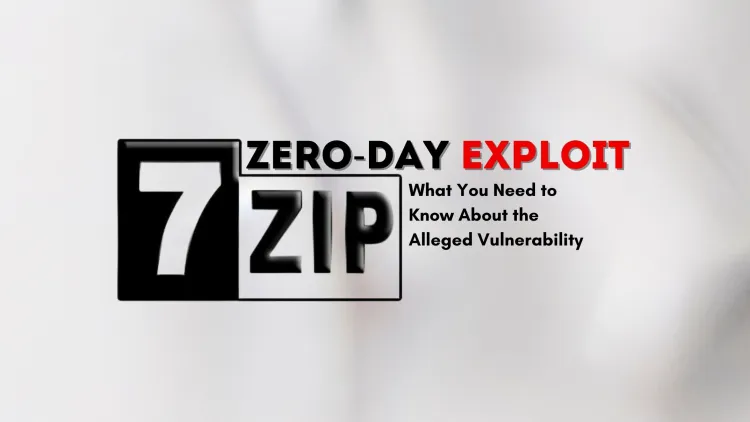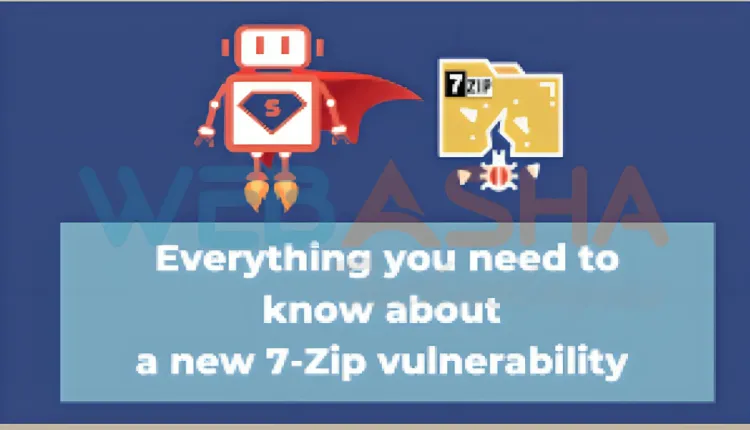7-Zip Zero-Day Exploit | What You Need to Know About the Alleged Vulnerability
The alleged 7-Zip zero-day exploit, disclosed by a hacker on X, targets the LZMA decoder to execute malicious code via crafted .7z files. While the exploit could streamline malware distribution and compromise automated workflows, 7-Zip's developer has denied its existence. This incident emphasizes the need for vigilant cybersecurity practices, including sandboxing files, educating users, and staying updated on software patches. The cybersecurity community must remain alert as the situation unfolds, ensuring systems and users are protected against potential threats.

7-Zip, one of the most widely used file compression utilities, has allegedly been compromised by a zero-day exploit disclosed by a hacker using the alias “NSA_Employee39” on X (formerly Twitter). This vulnerability, if proven genuine, could have severe implications for users and organizations globally. Here’s a detailed breakdown of the situation, its potential risks, and what you can do to stay secure.
What is the Alleged 7-Zip Zero-Day Exploit?
The alleged vulnerability, tracked as CVE-2024-11477, targets the LZMA decoder in 7-Zip. It exploits a malformed LZMA stream to trigger a buffer overflow in the RC_NORM function. This allows attackers to execute arbitrary code on a victim’s system by merely opening or extracting a malicious .7z file.
Key details include:
- Attack Methodology: The exploit uses a crafted LZMA stream to manipulate buffer pointers, enabling code execution without user interaction.
- Proof of Concept: The hacker demonstrated the exploit with a benign payload that launched Windows Calculator (calc.exe). However, this could easily be replaced with malicious payloads.
- Scope: The exploit could be used for targeted attacks, particularly against businesses or automated systems reliant on file extraction workflows.

Why This Exploit is Concerning
Impact on Infostealer Malware
This vulnerability could streamline malware distribution:
- Infostealers often use social engineering and password-protected archives to bypass security measures.
- The 7-Zip zero-day eliminates these complexities, allowing malware execution simply by opening a compromised
.7zfile.
Risks to Supply Chains
Organizations using automated workflows to process external files could unknowingly execute malicious code embedded in .7z archives, leading to:
- Data breaches
- Ransomware attacks
- Widespread system disruptions
Challenges for Attackers
While the exploit demands technical expertise, such as crafting shellcode within a limited 100-200 bytes, skilled adversaries can overcome these hurdles, escalating the threat level.
Response from 7-Zip’s Developer and Updates
Igor Pavlov, the creator of 7-Zip, has denied the claims:
- Statement: Pavlov clarified that no such vulnerability exists and that the RC_NORM function mentioned in the exploit is not part of the LZMA decoder.
- Further Investigation: Despite Pavlov’s assurances, cybersecurity experts are monitoring the situation closely, especially as the hacker hints at disclosing another zero-day for MyBB, an open-source forum software.
Steps to Mitigate Risk
-
Monitor for Official Updates:
- Stay informed via 7-Zip’s official website or trusted cybersecurity channels.
-
Use File Sandboxing:
- Implement tools that isolate and scan files before opening them to detect potential threats.
-
Raise Awareness:
- Train users to recognize the risks of opening unsolicited or suspicious archive files.
-
Stay Updated:
- Ensure all systems and applications, including antivirus software, are up to date.
-
Verify Source Integrity:
- Download 7-Zip and other utilities only from official sources to avoid tampered versions.
Broader Implications
The disclosure, whether genuine or not, highlights critical issues in responsible vulnerability disclosure. Unlike vulnerabilities reported through official channels, public leaks give attackers an immediate advantage while leaving developers scrambling to respond.
The cybersecurity community must collaborate to analyze these claims and prepare defenses, ensuring that users and organizations remain protected against potential exploitation.
Conclusion
While the validity of the 7-Zip zero-day exploit remains under scrutiny, its alleged capabilities underscore the importance of proactive cybersecurity measures. Whether a proof of concept or a genuine threat, this incident serves as a stark reminder to remain vigilant, implement best practices, and rely on trusted sources for software updates.
As the situation evolves, organizations and users must stay informed, follow mitigation strategies, and prioritize security in their digital operations.
FAQs
1. What is the 7-Zip zero-day exploit?
The alleged vulnerability, CVE-2024-11477, allows attackers to execute malicious code on systems by exploiting a buffer overflow in the LZMA decoder.
2. How does the exploit work?
It leverages a malformed LZMA stream to manipulate buffer pointers, enabling arbitrary code execution when a malicious .7z file is opened or extracted.
3. Who disclosed the vulnerability?
A hacker using the alias “NSA_Employee39” shared details of the exploit on X (formerly Twitter) and demonstrated it via a proof of concept.
4. What are the risks of this vulnerability?
Risks include malware infections, data breaches, and ransomware attacks, especially in supply chains and automated file workflows.
5. Is the vulnerability confirmed?
Igor Pavlov, the creator of 7-Zip, has denied the claims, stating that no such issue exists in the LZMA decoder.
6. What can attackers do with this exploit?
Attackers can execute arbitrary shellcode, potentially stealing data, installing malware, or compromising critical systems.
7. How can users protect themselves?
Avoid opening .7z files from unknown sources, use file sandboxing, and monitor 7-Zip for official updates.
8. Are there alternatives to 7-Zip?
Users concerned about security can consider other compression tools, such as WinRAR or PeaZip, but should still practice caution.
9. What should organizations do to mitigate risks?
Implement file scanning and sandboxing, restrict unauthorized file types, and educate employees on cybersecurity practices.
10. What is the broader impact of this incident?
The alleged exploit highlights the importance of responsible vulnerability disclosure and the need for robust cybersecurity practices.











![Top 10 Ethical Hackers in the World [2025]](https://www.webasha.com/blog/uploads/images/202408/image_100x75_66c2f983c207b.webp)

![[2025] Top 100+ VAPT Interview Questions and Answers](https://www.webasha.com/blog/uploads/images/image_100x75_6512b1e4b64f7.jpg)









